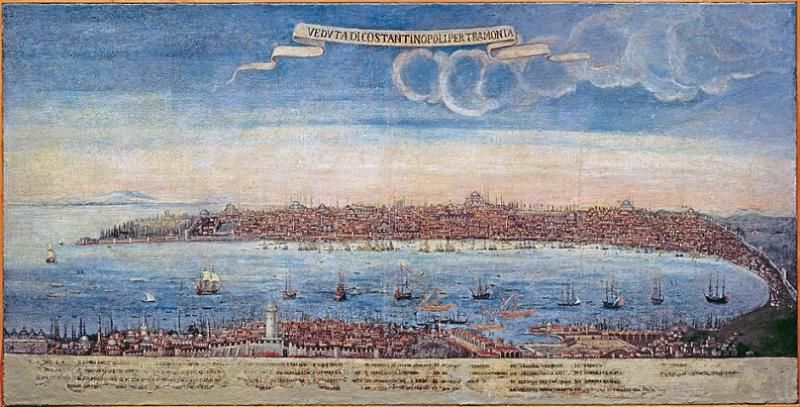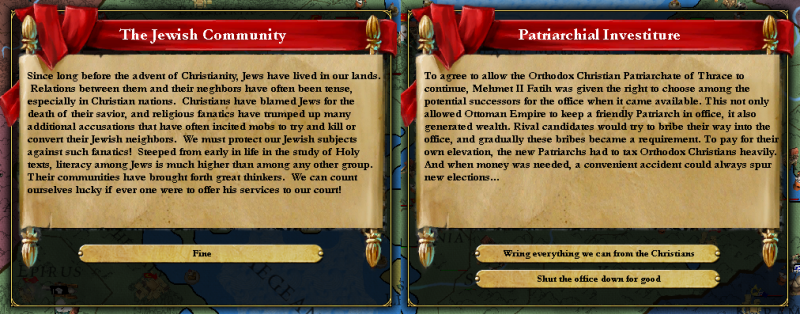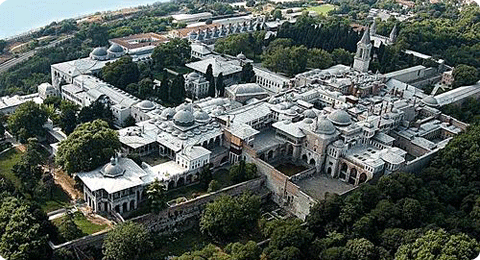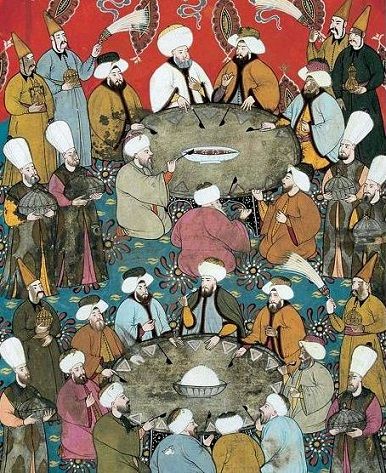The Shadow of God: An Ottoman History
- Thread starter Jape
- Start date
-
We have updated our Community Code of Conduct. Please read through the new rules for the forum that are an integral part of Paradox Interactive’s User Agreement.
You are using an out of date browser. It may not display this or other websites correctly.
You should upgrade or use an alternative browser.
You should upgrade or use an alternative browser.
The old Parthian Shot, eh? You think the Frenks would have learned how to deal with that by now, wouldn't you? 
Excellent stuff as always, I too would like to see more on domestic matters and the internal politics of the Sultan's court, but I suppose such things will have to wait until military matters are taken care of?
Excellent stuff as always, I too would like to see more on domestic matters and the internal politics of the Sultan's court, but I suppose such things will have to wait until military matters are taken care of?
WGPower: The consolidation of the Aegean and Anatolia are of primary importance to the Ottomans for several reasons I'll get into later. Internally, the need to occupy pretty much all of 'Turkey-in-Europe' against revolt, plus high war exhaustion and bad boy from the start weaken the economy but I'm still making 80-100 gold a year profit at this point.
Rifal: The Great Turk is in the ascendant but drawing a lot of attention I'd rather not have.
Tanzhang (譚張): A 500 year learning curve is pretty impressive but there we are. I'll be getting on to the domestic soon sir, frenk not.
Sandino: The fall of a gaggle of mainly Orthodox peasants to the Turks is nothing compared to the holding of Belgrade for Rome and her children. Of course the goal posts have just been moved closer to home...
---
Try to update by tomorrow but having a hectic few days.
EDIT: Update up, its a bit of a history lesson again but I hope it'll give people a flavour of how the Ottoman Empire functions. More war to follow!
Rifal: The Great Turk is in the ascendant but drawing a lot of attention I'd rather not have.
Tanzhang (譚張): A 500 year learning curve is pretty impressive but there we are. I'll be getting on to the domestic soon sir, frenk not.
Sandino: The fall of a gaggle of mainly Orthodox peasants to the Turks is nothing compared to the holding of Belgrade for Rome and her children. Of course the goal posts have just been moved closer to home...
---
Try to update by tomorrow but having a hectic few days.
EDIT: Update up, its a bit of a history lesson again but I hope it'll give people a flavour of how the Ottoman Empire functions. More war to follow!
Last edited:
4.
Power and Control in Mehmet's Empire
Power and Control in Mehmet's Empire

Constantinople in the late 15th century
The City
During Mehmet II’s twenty year reign, he spent twelve years on campaign [1]. It is ignorant however to view the Sultan as simply the ‘Grand Turk’ of European legend, a bloodthirsty warlord interested only in the sword. In his new capital of Constantinople, of which he was, we shall remember, heir not conqueror, he intended to resurrect what the Byzantines had considered the ‘navel of the world’ and surpass its historic greatness. He rebuilt the city walls and citadels, created public gardens, aqueducts and new palaces. Asia came to Europe. The churches became mosques; abandoned houses were donated to Anatolians moved to repopulate the city; the Turkish women took up the Byzantine veil in place of their linen hoods. While the old aristocracy was brutally purged for any misdemeanour against their new Caesar, the Greek merchants and artisans who had fled the city (many long before its capture for greener economic pastures) were welcomed back with open arms. The fierce old theologian Gennadius, Rome’s most implacable critic, was removed from his quiet exile and made Patriarch of the Orthodox Christians, overseeing their semi-autonomous millets [2] in Constantinople and across the Empire. Mehmet too brought the Chief Rabbi of Jerusalem, and the Armenian Patriarch from Bursa. He granted the Franciscan monks amnesty to travel Turkish lands and preach their teachings as they saw fit. All the religious leaders of the city were called on to translate their holy texts into Turkish.
This religious tolerance was based in part on the Islamic idea of Alh-ah-Kitab, or ‘People of the Book’ which respected Jews and Christians as followers of the Abrahamic God. It can also be seen to descend from the pluralism of Genghis Khan and his nomadic successors which was utilised as a pragmatic strategy to avoid conflict in vast empires of multiple faiths. While only Muslims could hold high office in the Ottoman state, for most of their history they simply saw the Christians and Jews as wayward brethren who would one day see the light. This atmosphere of liberalism went beyond faith and led the Genoese and Venetians to return with the Greeks to take up their trades once more, their business quarters returned to them without compensation. The following years saw Serbs, Albanians, Bulgars, Vlachs, Turcomen and others come, many captives of war transplanted into Mehmet’s cosmopolis. Italian humanists and Greek scholars were made guests of the Sultan, their books adding to his vast library. Mehmet cemented his absorption of Western thought with his own book, Siyasah [3], which claimed to combine Byzantine, Latin and Islamic theories of kingship into a new, uniquely Ottoman, philosophy.

Ottoman tolerance provided both spiritual peace and earthly rewards
For his seat of power, the Kaiser-i-Rum shunned the Great Palace of his Byzantine predecessors and instead built the Topkapi Palace, named after the nearby ‘Cannon Gate’ through which Mehmet had first arrived in Constantinople. To European eyes it was a squat, disorganised collection of courtyards, harems, kitchens and chambers, unbecoming of an emperor and paling in comparison to the great buildings being thrown up elsewhere in the city. These observations were partly informed by the medieval correlation of authority with military fortification. Why, an Ottoman might retort, would the Sultan barricade himself within the greatest city within the greatest empire the world had ever known? Topkapi was no castle but a microcosm of Mehmet’s realm. Based on the layout of a nomadic lord’s great tent, the outer courtyards were a bustle of activity were traders sought audiences with bureaucrats, the Sultan’s guard drilled and scholars debated the matters of the day. As one entered into the inner courtyards, a stoic silence grew. Gardeners quietly tended the orchards as clerics sat in contemplation beneath Cyprus trees.
Inside the actual chambers of the Sultan courtiers stood like statues, ready for their lord’s command. No word was spoken aloud unless Mehmet demanded it and often he himself would only talk in whisper to his grand vizier when not behind closed doors. This silence was so disciplined that by the start of the 16th century the denizens of Topkapi had perfected their own form of sign language [4]. Many Western visitors found the atmosphere otherworldly, even disturbing, though few were left in doubt of Mehmet’s authority and gravitas. Another quirk of the Ottoman court, which uneducated ambassadors often considered a humiliation designed to belittle Christians, was the grasping of their arms by courtiers before they knelt before the Sultan. This was in fact an act of security turned ritual, dating back to 1389 when Murad I had been assassinated by a Serbian envoy at the 1st Battle of Kosovo. For all his deference to Byzantium, it was at Topkapi, an itinerant khan’s yurt made permanent in stone and marble, that Mehmet established the Ottomans as nomad warriors turned imperial rulers. Giovanni de Tosca, a 17th century Italian merchant described Topkapi as the ‘eye of a storm’. For while the boundaries of the Empire spun in fast rotation, engulfing new conquests and new markets, at its centre the Sultan sat in sublime tranquillity, controlling chaos with absolute authority.

The sprawling Topkapi Palace would by expanded and renovated throughout the Empire's history
The State
The governmental structure of the Ottoman Empire was forced to expand and evolve rapidly during the reign of Mehmet II. Administration on a local level remained much as it had since the days of Osman, that is to say a labyrinthine mixture of religious, secular and military regulation. The millets, mentioned above, had no geographical boundaries and instead allowed Muslims, Christians and Jews to be judged by their own religious courts. Non-Muslims were granted this freedom, as well as exemption from military conscription [5] in return for the Jizya, a per capita tax. The highest level of provincial government was the eyalet, overseen by a beylerbey or governor-general. Appointed by the sultan, he oversaw tax collection, the census and the recruitment of troops in times of war. Often the sultan’s sons would be given control of an eyelet to educate them in ruling. Beneath this lay the timariots, the closest relations in the Empire to the feudal knights of Europe. Granted land (a timar) for military service, they and their successors would serve the beylerbey, enforcing taxes in their domain and raising a personal retinue for campaigns as payment for their fief. Technically separate from the eyalet but in reality heavily intertwined were military jurisdictions, overseen by Janissary commander. They were the professional garrisons of the Empire, answerable directly to the Sultan and positioned to combat revolt, invasion and an ambitious beylerbey if necessary. Though this cluttered system would in time cause problems for the Ottomans, it provided effective checks and balance, as well as security for Constantinople.
Regardless, the complexities of the eyalet, millet and timar required Mehmet’s central government to be drastically overhauled. New provinces in Anatolia, Greece, Albania, Montenegro, Serbia and Moldavia, warfare and an explosion in trade put great strain on the relatively small bureaucracy of the pre-1453 era. In moving his capital from Edirne the Sultan was able to absorb much of the Byzantine administration, including many of its former employees. Courts, tax offices, trade houses, census rolls and more besides were incorporated to give Mehmet a level of centralised control unheard of before in the Ottoman state; this was only a partial, stop-gap solution to the problem of ruling the new empire. A new generation of officials, scholars and soldiers were to be raised with the rapid expansion of two institutions: Devsirme and the Madrasa. Devsirme, translated ominously as the ‘blood tax’ was the Ottoman answer to the question that plagued all pre-modern states, how to devolve power from the monarch without ceding it entirely. The Persians had eunuchs, the Europeans had the Catholic clergy and the Chinese had their system of examinations. In Devsirme the Turks created a paradoxical class of slaves, destined to rule the empire but forever be property of the emperor.

A censor collects the 'blood tax'
It had long been a custom of Turkish tribes to enslave the children of their enemies to be raised as servants of their new lord. In 1432 Murad II translated the practice into state policy and upon this Mehmet pushed the boy tribute system to its logical conclusion. Every three years Ottoman officials travelled through the villages of Greece and the Balkans, selecting the finest of Christian youth to serve the Sultan. Eventually vast caravans of human levy passed from Europe into Constantinople. From here the boys were sent to Anatolian farms to build their strength and learn Turkish, before returning to the capital, converting to Islam and being enrolled into the Madrasa of the Fatih Mosque. The Madrasa were religious schools common across the Islamic world were students would be educated in literature, theology, mathematics and the sciences. Those of the Fatih Mosque were considered some of the finest schools in the Early Modern world and from here the boys would be split. Those deemed of a more intellectual bent would be recruited into the bureaucracy, while the physically capable would join the Janissary Corps.
The Janissaries were the backbone of the Ottoman military and to some extent the state itself. They acted as soldiers, sailors, firemen and policemen. The most capable could rise to become pashas and join the Sultan’s inner circle, or even be promoted to the office of Grand Vizier. Mehmet valued this system of authority as it removed the taint of nepotism, the purging of the Candarli family being an indication of his views on the subject [6]. By Islamic law Muslims could not be enslaved, which excluded the children of Janissaries from gaining entry into the Devsirme system, while marriage was discriminated against. Save the minor ‘barons’ of the Empire, the timariots, the Ottoman state was the only one in Europe without a hereditary aristocracy. The Janissaries were cut off from their homelands by distance and religion, lived in isolated barracks and were barred from growing beards, their long, drooping moustaches marking them as apart from Turkish society. Though a Devsirme recruit could grow rich and powerful in the Sultan’s service, all their worldly wealth remained the property of the Sultan and on their death would be returned to him [7]. Mehmet’s system ensured, at least theoretically, that none would grow to rival the House of Osman.

The Sultan dines with his Devsirme slaves
[1] This excludes the almost seasonal revolts of Serbs, Bulgars and anti-Semites in the Balkans.
[2] Administrative divisions based on religion.
[3] The title translates as Politics and introduced the word to the Turkish and Arabic vernacular.
[4] Many of the Sultan’s attendants were in fact deaf-mutes and it is from them the Kanunname, the court etiquette of Topkapi, developed.
[5] Plenty of Christians, particularly amongst Carpathian Vlachs, volunteered in times of war, acting as scouts and irregulars in return for plunder.
[6] See Chapter 1
[7] This doesn’t mean heirs might not be granted their father’s land or property but it would be gifted by the Sultan, not inherited by right.
Last edited:
Fantastic update to a fantastic AAR. The images choices are excellent and go well with the story. The Ottomans are one of my favorite countries to play in EU3, incidently, so I'm always a sucker for Ottoman AAR's!
Interesting stuff, I'd heard of the Janissaries but didn't know about the strange recruitment policy. Gives a nice a flavour of what the Turks are like.
You're laying the groundwork of your AAR far more carefully than I ever did (and honestly more carefully than I've seen in any AARs besides the occasional Vicky AAR). Up until recently I only set up a governmental structure to see a monarch tearing them down. I'm very interested to see how your AAR works out.
The Janissaries ... Mehmet’s system ensured, at least theoretically, that none would grow to rival the House of Osman.
Maybe not the House of Osman, but he laid the groundwork for problems down the road, albeit a long road. Great read, Jape. I've always had a weakness for this era.
Jape, Just letting you know that I've nominated this excellent AAR for the AAR Weekly Showcase. Keep up the great work and I'm looking forward to the next chapter!
I swear Jape, this AAR is like the History of the Ottoman Empire I never bothered to read. Great stuff.
MondoPotato: Glad to hear it and they are pretty fun to play aren't they? Cheers about the images, I was worried I'd struggle to find suitable period images but a little in-depth Googling has thrown up an amazing collection of Ottoman and European art perfect for my updates.
Sandino: I picked the Ottomans because they rarely get the history book treatment, I wanted a project that would educate myself as much as the readers and they're just on the edge of Europe so are familiar enough to the average AARer while still being pretty exotic. There's lots more fun oddities to come from our Turkish friends.
Merrick Chance': Cheers. I think a difficult task for this AAR is going to be dealing with government changes and the Ottomans' reaction to Western power as the years go on. The set-up is also partly for myself as much as anything, to give a rough outline of Turkish society as I've only learnt most of this stuff from a few dusty tomes in the past couple of weeks.
WGPower: Ha, glad you're enjoying it.
Dr. Gonzo: Well I'll consider it mission accomplished then! The Ottomans are fascinating bunch and hopefully I can balance AAR action with immersion into the Ottoman culture.
Lord Durham: Thanks, such praise from you means a lot. And I totally agree, the system Mehmet is setting up now has a sell-by date. Unlike the usual European power this isn't a rocky but inevitable march to modernity, the Ottomans have established an innovative variation of very ancient statecraft however this can easily stagnate. The thing I'm most looking forward to is watching the Sultans deal with decline and the threat 'modern' Western states pose.
Tanzhang (譚張): I'll take that as a compliment! They are an undervalued area of history particularly considering how important they were to this era, I hope to touch on certain areas that are criminally under looked (Ottoman involvement in the Indian Ocean Trade Wars for example) and if it gets you pick up a book on them it'd make my day. I might actually put a bibliography up on the contents post if people are interested.
Thank you so much, I really appreciate it!
--------
Got a few days off work so I'll try to get chapter 5 up tomorrow or Wednesday. Thanks for all the support guys!
Sandino: I picked the Ottomans because they rarely get the history book treatment, I wanted a project that would educate myself as much as the readers and they're just on the edge of Europe so are familiar enough to the average AARer while still being pretty exotic. There's lots more fun oddities to come from our Turkish friends.
Merrick Chance': Cheers. I think a difficult task for this AAR is going to be dealing with government changes and the Ottomans' reaction to Western power as the years go on. The set-up is also partly for myself as much as anything, to give a rough outline of Turkish society as I've only learnt most of this stuff from a few dusty tomes in the past couple of weeks.
WGPower: Ha, glad you're enjoying it.
Dr. Gonzo: Well I'll consider it mission accomplished then! The Ottomans are fascinating bunch and hopefully I can balance AAR action with immersion into the Ottoman culture.
Lord Durham: Thanks, such praise from you means a lot. And I totally agree, the system Mehmet is setting up now has a sell-by date. Unlike the usual European power this isn't a rocky but inevitable march to modernity, the Ottomans have established an innovative variation of very ancient statecraft however this can easily stagnate. The thing I'm most looking forward to is watching the Sultans deal with decline and the threat 'modern' Western states pose.
Tanzhang (譚張): I'll take that as a compliment! They are an undervalued area of history particularly considering how important they were to this era, I hope to touch on certain areas that are criminally under looked (Ottoman involvement in the Indian Ocean Trade Wars for example) and if it gets you pick up a book on them it'd make my day. I might actually put a bibliography up on the contents post if people are interested.
MondoPotato said:Jape, Just letting you know that I've nominated this excellent AAR for the AAR Weekly Showcase. Keep up the great work and I'm looking forward to the next chapter!
Thank you so much, I really appreciate it!
--------
Got a few days off work so I'll try to get chapter 5 up tomorrow or Wednesday. Thanks for all the support guys!
Tanzhang (譚張): I'll take that as a compliment! They are an undervalued area of history particularly considering how important they were to this era, I hope to touch on certain areas that are criminally under looked (Ottoman involvement in the Indian Ocean Trade Wars for example) and if it gets you pick up a book on them it'd make my day. I might actually put a bibliography up on the contents post if people are interested.
It was meant as one! I was shocked to find out in doing some research on the East Indies for my own AAR just how influential the Ottomans were in that region, right up until the 19th century in some cases. I for one would be very interested in a bibliography should you choose to post one; there are literally hundreds of books on the Ottomans floating about online and for someone with very little knowledge on the subject like myself finding a foothold can be a bit daunting.
Oh, if you are going to try to replicate the ottomans' involvement in the Indian Ocean of the middle XVIth century, It would be pretty great.
I read a great book about this usally disregarded part of Ottomans history: Giancarlo Casale, The Ottoman Age of Exploration.
However, I always find it very difficult to do the same thing as IRL with EU3: building a navy in Egypt, conquering parts of Arabia and Erythrea, trying to gain some outposts in India...
I read a great book about this usally disregarded part of Ottomans history: Giancarlo Casale, The Ottoman Age of Exploration.
However, I always find it very difficult to do the same thing as IRL with EU3: building a navy in Egypt, conquering parts of Arabia and Erythrea, trying to gain some outposts in India...
Sandino: I picked the Ottomans because they rarely get the history book treatment, I wanted a project that would educate myself as much as the readers and they're just on the edge of Europe so are familiar enough to the average AARer while still being pretty exotic. There's lots more fun oddities to come from our Turkish friends.
Well for my self at least I can say I'm having fun with the historical tid bits, updating soon?
Hey Jape I just want you to know that I wrote a glowing review of your thing on the AARlander thing
Tanzhang (譚張): The Indian Ocean might be the most important yet overlooked region in world history and as you say the Ottomans had quite an important role particularly in the 16th century. I'll get the bibliography up soon then, hope it helps.
MiniaAr: Aye the EU3 engine can make attempting particular historical acts a chore but hopefully I can at least bring a flavour of those events into my AAR
Sandino: Hopefully!
Merrick Chance': I read your thing reviewing my thing on the AARlander thing and I thank you for the generous write up.
-----
Sorry guys I've had serious writer's block with Chapter 5 and my new job has made my free time quite unpredictable. Hopefully it will be up by the weekend.
I have also been writing elsewhere so if anyone enjoys sub-Onion quality spoof news, I've started a writing exercise in the form of the Hawk! check it out if it interests you.
MiniaAr: Aye the EU3 engine can make attempting particular historical acts a chore but hopefully I can at least bring a flavour of those events into my AAR
Sandino: Hopefully!
Merrick Chance': I read your thing reviewing my thing on the AARlander thing and I thank you for the generous write up.
-----
Sorry guys I've had serious writer's block with Chapter 5 and my new job has made my free time quite unpredictable. Hopefully it will be up by the weekend.
I have also been writing elsewhere so if anyone enjoys sub-Onion quality spoof news, I've started a writing exercise in the form of the Hawk! check it out if it interests you.

